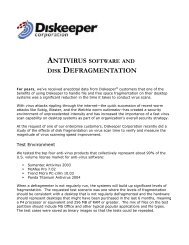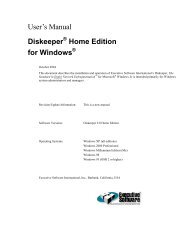Diskeeper 10 User's Manual
Diskeeper 10 User's Manual
Diskeeper 10 User's Manual
You also want an ePaper? Increase the reach of your titles
YUMPU automatically turns print PDFs into web optimized ePapers that Google loves.
28 <strong>Diskeeper</strong> Operation<br />
To access the properties for any type of job, click the respective toolbar button, or select the same from the<br />
Quick Launch pane. This launches a separate dialog, which varies depending on the job type. For example, the<br />
Job Properties dialog for any of the four Set It and Forget It job types includes a Computer pane, listing the<br />
volumes available for that particular job type. On the other hand, the <strong>Manual</strong> Defragmentation Job Properties<br />
dialog does not show the Computer Pane, since it is only used for job scheduling, and <strong>Manual</strong> Defragmentation<br />
Jobs are, by their very nature, not scheduled. In all cases, the Job Properties Dialog contains instructive text<br />
describing the options available and or other useful information.<br />
<strong>Manual</strong> Defragmentation Mode<br />
<strong>Diskeeper</strong> is designed to be operated in two ways —the <strong>Manual</strong> Defragmentation mode and Set It and Forget It<br />
mode.<br />
The <strong>Manual</strong> Defragmentation mode allows you to control <strong>Diskeeper</strong> operation directly. You have direct control<br />
over which volumes are defragmented, when defragmentation is started and stopped, and other <strong>Manual</strong><br />
Defragmentation jobs properties.<br />
There are several ways by which to start <strong>Diskeeper</strong> manually, but the most direct method is simply to highlight<br />
the volume you want to defragment, then click the Defragment button below the Computer pane.<br />
Alternatively, right-click a volume and select Defragment.<br />
Tip: You can also use the Defragment button<br />
to start defragmenting the selected<br />
volume.<br />
With most editions of <strong>Diskeeper</strong>, you can run more than one manual defragmentation job at the same time.<br />
Note that different editions of <strong>Diskeeper</strong> support different numbers of simultaneous operations. See page 61 for<br />
a table showing the different <strong>Diskeeper</strong> editions and the number of simultaneous operations each supports.<br />
To stop a manual <strong>Diskeeper</strong> job, first highlight the volume you want to stop defragmenting, then either click the<br />
Stop button on the <strong>Diskeeper</strong> toolbar or right-click the volume and select Stop.<br />
If you exit from <strong>Diskeeper</strong> (or even log off your computer) while a manual defragmentation job is running, the<br />
job will continue running until it is complete.<br />
There are several options available to control how <strong>Manual</strong> Defragmentation Jobs run. These options are<br />
available via the <strong>Manual</strong> Defragmentation Job Properties dialog. To view and edit the <strong>Manual</strong> Defragmentation<br />
Job Properties, click the <strong>Manual</strong> Defragmentation Job Properties button in the toolbar, or click Analyze and<br />
Defragment Now in the Quick Launch pane and select <strong>Manual</strong> Defragmentation Job Properties.<br />
<strong>Manual</strong> Defragmentation Jobs offer you a choice of two different defragmentation methods—the “Quick”<br />
defragmentation method and the “Recommended” (default) defragmentation method. Select the method of your<br />
choice via the <strong>Manual</strong> Defragmentation Job Properties dialog described above. The method you choose will be<br />
applied to all <strong>Manual</strong> Defragmentation Jobs. See page 43 for more information about the defragmentation<br />
methods available.<br />
By default, manual defragmentation jobs are run at “Normal” priority, the mid-level Windows priority. Because<br />
of this, the performance of tasks running on your computer other than the defragmentation job can be affected.<br />
As an option, you can change the priority at which <strong>Diskeeper</strong> runs for manual defragmentation jobs via the<br />
<strong>Manual</strong> Defragmentation Job Properties dialog described above. Lowering the priority of <strong>Diskeeper</strong> jobs can<br />
help speed the performance of other tasks on your system running at the same time, but can cause <strong>Diskeeper</strong> to<br />
take longer to defragment your volumes. See page 44 for more information about setting the <strong>Diskeeper</strong> priority.<br />
Note: <strong>Diskeeper</strong> Home Edition does not support changing the defragmentation priority.






